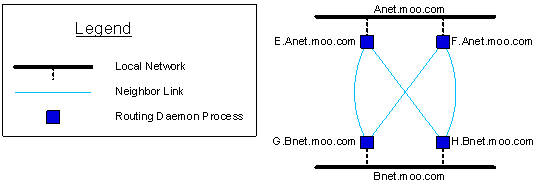Redundant Routing Daemons for Fault Tolerance
Rendezvous routing daemons can cooperate for fault-tolerant service. Fault tolerance protects routing daemons against hardware failures, process failures and network segmentation.
In Fault Tolerance among Routing Daemons, two routing daemon processes, E.Anet.moo.com and F.Anet.moo.com, run on separate host computers, and serve the local client network Anet.moo.com; similarly, routing daemons G.Bnet.moo.com and H.Bnet.moo.com both serve local client network Bnet.moo.com. Neighbor links connect E with G and H, and also F with G and H. Although these neighbor links offer redundant paths from Anet to Bnet, the routing daemons cooperate to forward each message only once. In failure situations, the routing daemons automatically readjust to continue service smoothly.
The concepts of primary and secondary do not apply to redundant routing daemons. Instead load balancing parameters govern fault-tolerant behavior (see Load Balancing).
In groups of redundant routers (such as E and F), the router names must be distinct, the local network configurations must be identical, while the load balancing parameters along neighbor links may differ.
Notice that E and F are not neighbors, nor are G and H. It would be an error for neighbors to serve the same local network (see Common Topology Errors).
